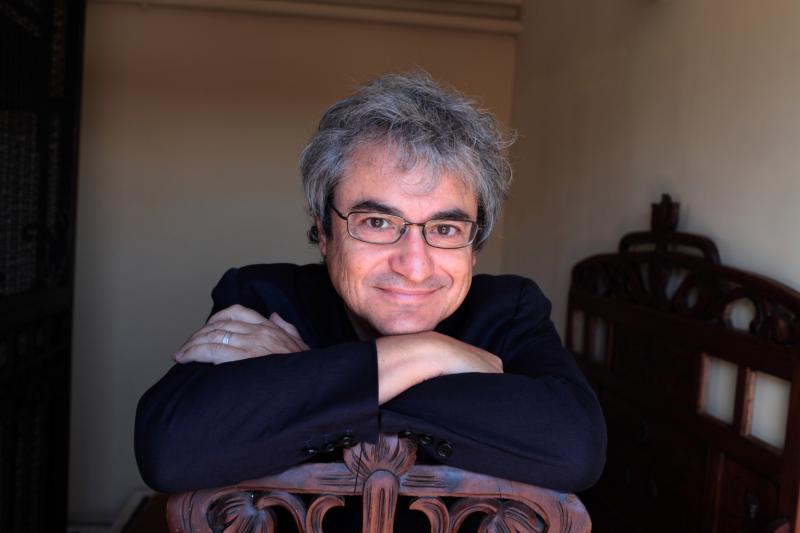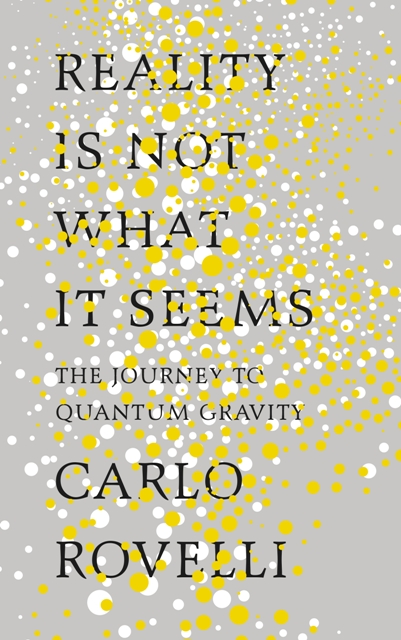Sunday Book: Carlo Rovelli - Reality Is Not What It Seems | reviews, news & interviews
Sunday Book: Carlo Rovelli - Reality Is Not What It Seems
Sunday Book: Carlo Rovelli - Reality Is Not What It Seems
The author of 'Seven Brief Lessons in Physics' gives his expanded vision

Scientists today tend to patronise the early Greek philosophers who, 2500 years ago, inaugurated enquiry into the nature of things. The Atomic Theory? A lucky guess, they allege. But Carlo Rovelli accords them, and especially Democritus, the key atomist, pride of place in his narrative: a see-saw battle between notions that the world consist of discrete units, beyond which we cannot go, and the idea of continuum without beginning or end.
Rovelli gives these abstractions a local habitation and a name, using the insights of the Greek philosophers and the Latin poet Lucretius, who wove the atomic theory into the passionate, sensuous and astonishingly prescient poem, "On the Nature of Things", and whose “we all spring from heavenly seed” finds an echo today in Joni Mitchell’s “We are stardust, we are golden...” The author belongs to the great Italian One-Culture tradition encompassing science and literary humanism that begins with Lucretius, and takes in Dante, Leonardo, Galileo, Primo Levi and Italo Calvino. Rovelli proclaims: “Our culture is foolish to keep science and poetry separated: they are two tools to open our eyes to the complexity and beauty of the world.”
A wonderful line of reasoning runs from the founders of Greek atomism to Einstein, who finally proved in 1905 that atoms are real, and even determined their size. Like the Greeks, Einstein is a touchstone throughout, although Rovelli misses one slight trick: in 1923, Einstein actually wrote a foreword for a new German translation of Lucretius's great poem, neatly capping the 2500-year story.
 That atoms are discrete particles was the first answer to crystallise in the particulate vs continuum debate and Rovelli shows us how subtly right the Greeks were in their arguments. But in the 19th century, light, electricity and magnetism were all declared to be continuous wave phenomena. Then, in the early 20th century, matter and waves (or the force fields in which waves occur) were shown to have a dual nature, sometimes manifesting as one, sometimes as the other: hence the electron microscope, in which electrons, normally thought of as particles, behave like waves, enabling far smaller structures to be seen than with a light microscope. But now, 100 years later, the ultimate reality seems to be particulate: only in mathematics can something be infinitely smoothly connected: in Rovelli’s theory, even space itself seems, counterintuitively, to be composed of very tiny units beyond which you cannot go.
That atoms are discrete particles was the first answer to crystallise in the particulate vs continuum debate and Rovelli shows us how subtly right the Greeks were in their arguments. But in the 19th century, light, electricity and magnetism were all declared to be continuous wave phenomena. Then, in the early 20th century, matter and waves (or the force fields in which waves occur) were shown to have a dual nature, sometimes manifesting as one, sometimes as the other: hence the electron microscope, in which electrons, normally thought of as particles, behave like waves, enabling far smaller structures to be seen than with a light microscope. But now, 100 years later, the ultimate reality seems to be particulate: only in mathematics can something be infinitely smoothly connected: in Rovelli’s theory, even space itself seems, counterintuitively, to be composed of very tiny units beyond which you cannot go.
Rovelli’s quest, like that of thousands of physicists the world over, is to bring gravity within the scope of the otherwise all-embracing standard physical model that accounts for every force of attraction except for Newton’s equations of 1687. The latter would have sufficed to put a man in the moon or the Rosetta spacecraft on its asteroid even without Einstein’s later corrections; they work but we still don’t know why. It is a bizarre anomaly.
For most of the book, Rovelli’s exposition, guided by his Greek heroes, is enthralling in its clarity, vision and poetic wisdom. But the chase has a beast in view. The search for quantum gravity, the missing link in physical theory is Rovelli’s passionate research interest and when he comes up to the present, things get a little wild and woolly. Rovelli is so immersed in his theories that he loses some of his explanatory power: we have to take on trust his views on the loop quantum gravity that emerges from certain equations. Other physicists have a different set of equations pointing to string theory (which he does mention). At this point, the reader is likely to want to wait for some evidence.
Which is now just beginning to come in. Gravitational waves from a collision between two black holes were detected for the first time in February this year. These ripples in the fabric of spacetime can only show the wave nature of gravity, not its supposed granularity.
If the quest for quantum gravity in the latter half of the book is, as Rovelli admits at one point, tough going compared to the luminous poetic account up to the 20th century, that is because science works at the coalface of ignorance, hacking and hewing through rival conjectures until the best fit is achieved. He recovers his eloquent poise at the end, elevating scientific uncertainty to a great principle. In the teeth of all trammelling dogmas and creeds, he elevates Socrates’ modest admission to the status of a scientific credo: “I’m not sure”.
- Reality Is Not What It Seems by Carlo Rovelli, Allen Lane, £16.99
rating
Explore topics
Share this article
The future of Arts Journalism
You can stop theartsdesk.com closing!
We urgently need financing to survive. Our fundraising drive has thus far raised £49,000 but we need to reach £100,000 or we will be forced to close. Please contribute here: https://gofund.me/c3f6033d
And if you can forward this information to anyone who might assist, we’d be grateful.

Subscribe to theartsdesk.com
Thank you for continuing to read our work on theartsdesk.com. For unlimited access to every article in its entirety, including our archive of more than 15,000 pieces, we're asking for £5 per month or £40 per year. We feel it's a very good deal, and hope you do too.
To take a subscription now simply click here.
And if you're looking for that extra gift for a friend or family member, why not treat them to a theartsdesk.com gift subscription?
more Books
 'We are bowled over!' Thank you for your messages of love and support
Much-appreciated words of commendation from readers and the cultural community
'We are bowled over!' Thank you for your messages of love and support
Much-appreciated words of commendation from readers and the cultural community
 Robin Holloway: Music's Odyssey review - lessons in composition
Broad and idiosyncratic survey of classical music is insightful but slightly indigestible
Robin Holloway: Music's Odyssey review - lessons in composition
Broad and idiosyncratic survey of classical music is insightful but slightly indigestible
 Thomas Pynchon - Shadow Ticket review - pulp diction
Thomas Pynchon's latest (and possibly last) book is fun - for a while
Thomas Pynchon - Shadow Ticket review - pulp diction
Thomas Pynchon's latest (and possibly last) book is fun - for a while
 Justin Lewis: Into the Groove review - fun and fact-filled trip through Eighties pop
Month by month journey through a decade gives insights into ordinary people’s lives
Justin Lewis: Into the Groove review - fun and fact-filled trip through Eighties pop
Month by month journey through a decade gives insights into ordinary people’s lives
 Joanna Pocock: Greyhound review - on the road again
A writer retraces her steps to furrow a deeper path through modern America
Joanna Pocock: Greyhound review - on the road again
A writer retraces her steps to furrow a deeper path through modern America
 Mark Hussey: Mrs Dalloway - Biography of a Novel review - echoes across crises
On the centenary of the work's publication an insightful book shows its prescience
Mark Hussey: Mrs Dalloway - Biography of a Novel review - echoes across crises
On the centenary of the work's publication an insightful book shows its prescience
 Frances Wilson: Electric Spark - The Enigma of Muriel Spark review - the matter of fact
Frances Wilson employs her full artistic power to keep pace with Spark’s fantastic and fugitive life
Frances Wilson: Electric Spark - The Enigma of Muriel Spark review - the matter of fact
Frances Wilson employs her full artistic power to keep pace with Spark’s fantastic and fugitive life
 Elizabeth Alker: Everything We Do is Music review - Prokofiev goes pop
A compelling journey into a surprising musical kinship
Elizabeth Alker: Everything We Do is Music review - Prokofiev goes pop
A compelling journey into a surprising musical kinship
 Natalia Ginzburg: The City and the House review - a dying art
Dick Davis renders this analogue love-letter in polyphonic English
Natalia Ginzburg: The City and the House review - a dying art
Dick Davis renders this analogue love-letter in polyphonic English
 Tom Raworth: Cancer review - truthfulness
A 'lost' book reconfirms Raworth’s legacy as one of the great lyric poets
Tom Raworth: Cancer review - truthfulness
A 'lost' book reconfirms Raworth’s legacy as one of the great lyric poets
 Ian Leslie: John and Paul - A Love Story in Songs review - help!
Ian Leslie loses himself in amateur psychology, and fatally misreads The Beatles
Ian Leslie: John and Paul - A Love Story in Songs review - help!
Ian Leslie loses himself in amateur psychology, and fatally misreads The Beatles
 Samuel Arbesman: The Magic of Code review - the spark ages
A wide-eyed take on our digital world can’t quite dispel the dangers
Samuel Arbesman: The Magic of Code review - the spark ages
A wide-eyed take on our digital world can’t quite dispel the dangers

Add comment